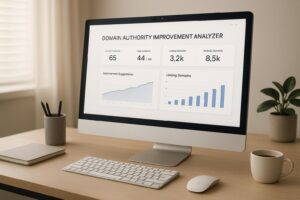Last Updated on May 14, 2025 by Becky Halls
So you’ve got a website – great! But if no one’s visiting it, you might as well have opened a shop in the middle of a desert. Don’t worry, though. Driving traffic to a website doesn’t have to be rocket science. With the right mix of strategy, creativity, and consistency, you can turn your website into a buzzing hub of activity.
In this quick article, we’ll cover how to drive traffic to a website using proven methods like SEO, content marketing, social media, and more… We’ll include real-world examples and practical (yet simple) tips so you can stop guessing and start growing.
1. Master the Basics of SEO
Search Engine Optimization (SEO) is still the backbone of organic traffic. If you want to drive traffic to a website without paying for every click, you need to rank in search engines.
Key SEO tips:
- Do keyword research: Use tools like Ahrefs, Ubersuggest, or Google Keyword Planner.
- Optimize your pages: Include keywords in titles, meta descriptions, headers, and naturally within content.
- Improve technical SEO: Ensure your site loads fast, is mobile-friendly, and free of crawl errors.
- Create internal links: Guide users (and search engines) around your site more effectively.
Example: A local florist started optimizing blog posts for “wedding flower trends 2025” and saw a 40% increase in organic traffic within 3 months.
2. Start a Content Marketing Engine
Content is still king! But that’s only true if it’s helpful, original, and aligned with what your audience is searching for.
Create content that:
- Solves a specific problem
- Educates or entertains
- Is keyword-optimized for search
Try different formats like:
- Blog posts
- Videos
- Infographics
- Case studies
- How-to guides
Example: A SaaS company published a “State of Industry” report filled with original stats. It not only helped drive traffic to their website, but also attracted high-quality backlinks.
3. Leverage Social Media Platforms
If you’re not using social media to promote your content, you’re leaving visibility on the table.
Tips for using social media to drive traffic:
- Choose platforms where your audience hangs out (LinkedIn for B2B, Instagram for lifestyle, TikTok for Gen Z, etc.)
- Repurpose your blog posts into short video snippets, carousels, or quote graphics
- Include strong calls-to-action (e.g., “Read the full article here”)
- Engage with your followers and in relevant groups or hashtags
Example: A fitness coach repurposed her blog content into reels and stories on Instagram, resulting in a 65% increase in referral traffic over 6 weeks.
4. Collaborate Through Guest Posting and Link Exchanges
Publishing on other websites exposes your brand to new audiences and it builds your authority.
Effective tactics:
- Pitch guest posts to blogs in your niche
- Add your site to ethical link exchange platforms like 3Way.Social
- Offer to write or co-create content in exchange for backlinks
These methods not only drive traffic to a website, they also improve your SEO by building high-quality backlinks.
5. Start an Email Newsletter
Email marketing is far from dead. In fact, it’s one of the most cost-effective ways to keep people coming back to your site.
What to send:
- Weekly tips or insights
- New blog posts or product updates
- Exclusive offers or discounts
- Behind-the-scenes content
Pro Tip: Include clickable CTAs in every email—don’t just inform, inspire action.
Example: An eCommerce brand added a blog roundup to their monthly emails, which helped drive traffic to the website and increased time on site by 30%.
6. Use Paid Ads (Strategically)
If you want faster results, pay-per-click (PPC) advertising can be a powerful way to drive traffic to a website (but only if done right).
Where to advertise:
- Google Search and Display
- Facebook and Instagram Ads
- LinkedIn Ads (for B2B)
- Pinterest and TikTok Ads
Start small, test creatives, and focus on high-intent audiences.
Example: A startup invested $200 in a Google Ads campaign targeting long-tail keywords. They landed on page one for their niche and doubled their web traffic in a month.
7. Optimize for Voice and Mobile Search
In 2025, more people than ever are using voice search or browsing on mobile devices.
Quick wins:
- Use conversational keywords (e.g., “how do I…” or “what’s the best way to…”)
- Format answers using bullet points or short paragraphs
- Ensure your site is lightning-fast on mobile
These tweaks improve accessibility and help drive traffic to your website by meeting users where they are.
8. Engage with Communities and Forums
Sometimes, the best way to drive traffic to a website is by being helpful in communities where your audience already hangs out.
Where to join in:
- Reddit threads in your niche
- Facebook or LinkedIn groups
- Quora or Stack Exchange
- Niche forums
Provide thoughtful answers, then gently link back to your content when relevant (no spam!).
Example: A productivity app founder shared solutions in Reddit’s r/productivity and included a link to their blog post, earning thousands of clicks without spending a dime.
Final Thoughts: Drive Traffic with Purpose
The truth is, there’s no one-size-fits-all magic button to drive traffic to a website. It takes a mix of strategies, a good understanding of your audience, and a willingness to experiment.
Start with the methods that best fit your business and resources. Track what works. Double down on those efforts, and most importantly, keep your content useful, relevant, and human.
Because traffic doesn’t come from algorithms alone. It comes from people, so give them a reason to visit… and to come back…






